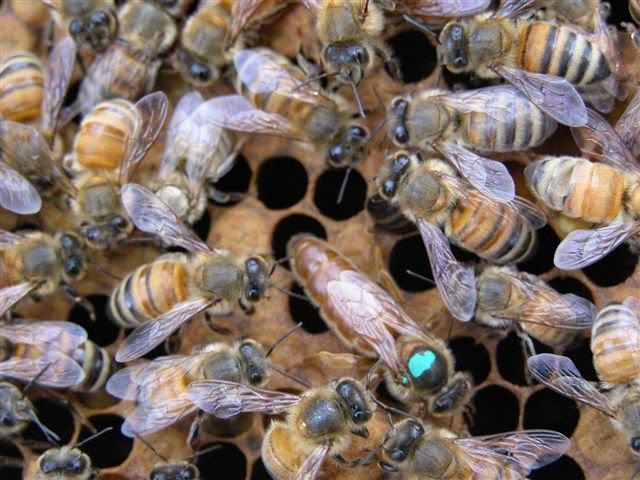|
|
Post by Blueflint on Apr 19, 2007 14:32:10 GMT -5
Planting and keeping corns pure can be a challenge, specially in the corn belt. Corn is absolutely horrible about cross pollination and isolation is the best method but isn't always possible. I grow a variety of very rare Native American corns originally from several eastern tribes. As I live in the middle of several hundred acres of corn and beans, I have to time things just right to avoid cross pollination with my rare native corns and the area's field hybrids. One trick this year since all of the acreage here will be in field corn is to start a very short season veriety as early as possible so it will be done and actually drying down before the field corn starts to tassle. This year's early planted variety is Bear Island Chippewa. A very short season nice multi colored corn that is ready to pick in 60 days. This year, I started seed three weeks ago in the greenhouse, then transplanted the 6" tall plants into the garden today (April 19). They will recover from transplant shock in about 7 days and then take off growing. This gives me a 2 week jump over direct seed planting and a big jump on the area's field corn. Once the local field corn has been in for 30 days, I will plant another Native corn which will has a seed to tassle length 10 to 15 days longer than the field hybrids which will give me a 5 to 6 week buffer on pollination after the field corns, resulting in pure late crop even in this close proximity. When it comes to corn purity, there can be no guess work. I hope these tips will help others out.
|
|
brook
gardener
  
Posts: 127
|
Post by brook on Apr 19, 2007 16:10:17 GMT -5
Hey, Blueflint. Welcome.
People, Blueflint is a specialist in saving Native American seeds. I'm chomping at the bit to get the three Cherokee beans he just sent me in the ground.
He'll be giving a presentation on Native American varieties in October, at the AHSC Fall Conference. Y'all ought to plan on attending.
|
|
|
|
Post by cff on Apr 19, 2007 16:57:46 GMT -5
Hey maybe we could talk him into doing an online presentation for us folks down south?
|
|
|
|
Post by Alan on Apr 19, 2007 21:00:01 GMT -5
I'm gonna try my hardest to make it down there this year and definetly look forward to hearing blueflint talk.
|
|
|
|
Post by flowerpower on Apr 20, 2007 6:41:41 GMT -5
Welcome, Blueflint. If you do any talks in the NY area, please let me know.
|
|
|
|
Post by Blueflint on Apr 22, 2007 20:40:44 GMT -5
Hi Guys,
Glad to be here. How about after the fall conference I take my notes from the presentation and do a re-run over them here online? I'll also pop in on occasion and give other tips.
The three beans Brook is talking about are: Cherokee Bush, Price's Cherokee and October Bush. "October" is a well documented Cherokee bean from Tennessee. Plump light cream colored with wine streaks, these dry beans are produced on bush plants. The "Cherokee Bush" came from Jon Pittman in Kentucky and came from his Cherokee ancestors. This is a small black bean, compact bush plants, some with weak runners, prolific producers. "Price's Cherokee" came from the Price family, carried over the Trail of Tears to Oklahoma and in later years the family moved to California taking these beans with them. The UC Davis Seed Saving Project collected these in the mid to late 1980's. This is a pole bean with a medium to large cream colored dry bean. This is just a little look at the many rare Cheokee beans I have collected over the years and do my best at preserving for our future.
|
|
|
|
Post by Blueflint on May 19, 2007 10:08:25 GMT -5
It has been one month since I talked about transplanting my short season Chippewa corn. We have went thru several short cold snaps including 2 days ago it got to 57 was all and this morning it was 40 out. Anyone who grows corn knows it doesn't care for cool weather.
The Bear Island Chippewa has rooted in well, grown pretty good and actually has tassles pushing up from their small plant centers. Tassles are up about 4" from the worl. These little guys only get 36" tall or so since they are adapted to the northern cool short seasons. They should be pollinating in about a week. Local field corn is doing well (up 8") but won't be pollinating for about 6+ weeks yet...lots of buffer time.
Blueflint
|
|
|
|
Post by Blueflint on May 31, 2007 7:46:11 GMT -5
Chippewa corn has been in full pollination since May 26 and coming along nicely. Plants have finally stretched to their final heigth of 36" or so. Tassels range in colors from cream to deep crimson red to dark orange and even violet. Yes...tasselled corn in May in zone 5B/6A
Blueflint
|
|
|
|
Post by Alan on May 31, 2007 8:50:39 GMT -5
That's great to hear blueflint! I'm glad your corn is doing well! Keep us updated friend.
-alan
|
|
|
|
Post by johno on Oct 4, 2007 22:31:28 GMT -5
Hi Blueflint,
How'd the Chippewa turn out?
Any chance you got your notes together before the event was cancelled? I'd like to hear more from you!
|
|
|
|
Post by Blueflint on Nov 1, 2007 19:03:49 GMT -5
Bear Island Chippewa corn did well, even with the extreme heat and drought. These were planted early enough in the season not to suffer much. These were transplanted from greenhouse starts into the ground on April 19. Tasselled and pollen shed started May 23. I started to pick ears with outer husks turned brown on June 18. All were picked by July 1.
I planted an old kentucky white dent variety (Morgan County White) on June 14. This is late for a long season variety but was time staggered to prevent crossing with other area corn. Due to the dryness and heat, plants ranged from 5' to 12' tall and ears also ranged in length a lot. I picked the ears in early October and they are now dry enough to shell off and bag up for storage. Overall I got enough fresh seed from this small plot to plant close to 1/2 an acre in 2008.
Blueflint
|
|






